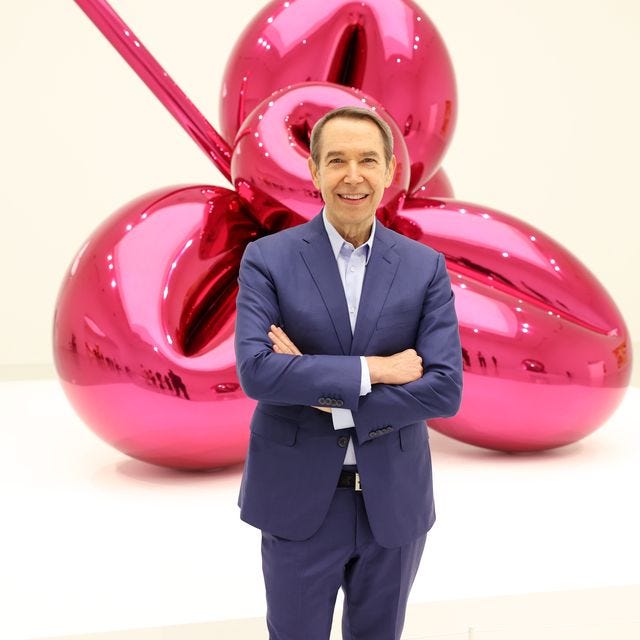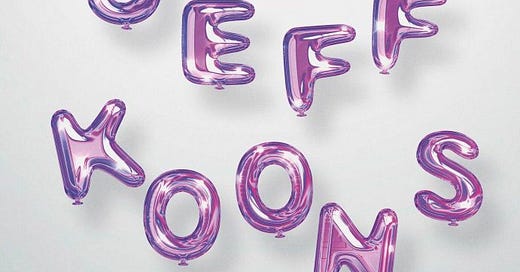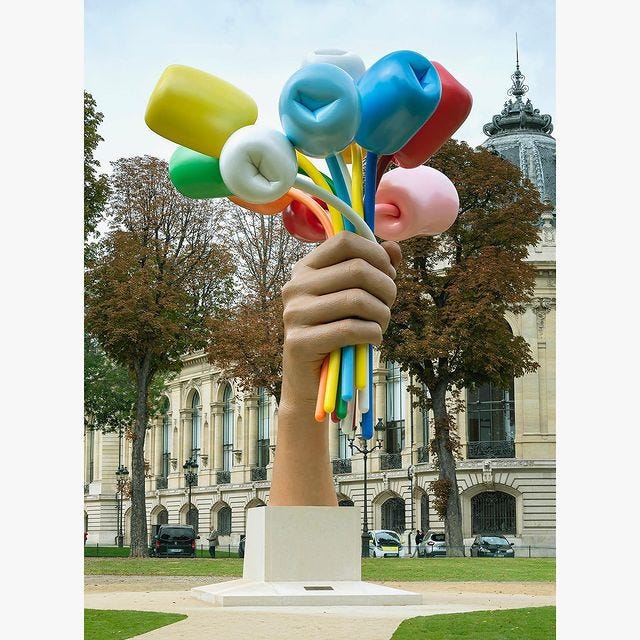A NOTE BEFORE OUR REGULARLY SCHEDULED PROGRAMING: I am starting a new project called The Pacific Northwest Conceptual Art Center. I’m still in the process of deciding what exactly it will look like, but it will be similar to Welcome to Business School in that it will be a simulation that also kinda functions as the thing it pretends to be. Hence the change in the newsletter name. I’ll still be writing about art and business in the newsletter, but I’m gonna also start looking at work that functions outside the markets. I’ve had my MFA for almost half a year now, and it’s become clear to me that there isn’t much set up to support conceptual artists that aren’t embedded in the university system. So, I’m gonna pretend to be that thing for a while and see what happens. I’ll get back to you later with the details.
Jeff Koons is Perfect
In December 2022, as part of my MFA thesis project, I wrote a newsletter about artist Jeff Koons and how he uses multiples to make art boring. That’s probably not what he’s aiming for, but good intentions don’t always have good results. You can read my essay here, but long story short, the people who can afford to buy investor-grade art collect Koons because he positions himself to give them exactly what they want. By making his work in small editions or creating similar items with variations in color or historical references, he makes it easy for the super-rich to buy what he’s selling. There are enough items so they can all have one — with some competition,— but few enough so the rest of us cannot. (Although Koons has ensured we can all participate in the market by also making smaller, mass-produced versions. I guess the democratization of art is here?) In that previous essay, I didn’t write about the content of his work, but I’ll be doing some of that here and how he provides the ultrawealthy with art that reflects their life and experiences.
If you don’t know who Koons is, you can look at some of his work here, but he’s this guy:

In my normal, everyday life I don’t think much about Koons, but I’ve had several (and by several, I mean four) interesting stories about him come through my newsfeed lately, and I wanted to address them because they sparked an interest in how he relates to the press, how he works to control his image, and how his public persona contributes to how people view his art. Most of what interests me about Koons is what happens behind the curtain, and while I can’t know exactly what goes on back there, I can make some guesses based on what I can see.
Jeff Koons: A Private Portrait (2023)
A new documentary, Jeff Koons: A Private Portrait, was in the theaters recently, so I dragged my poor husband to it. To be honest, it’s boring. It’s mostly about his life and his kids, and there’s not really enough there to tell an engaging story. Koons had a happy childhood, worked hard to be successful, and loves being a dad. There is a lot about his parenting in this movie. He has six kids with his current wife, one son who grew up in Italy with his previous spouse, and one daughter who was given up for adoption at birth. The most interesting part of the movie is about his attempts to establish relationships with the children who didn’t grow up in his household, and in the end, everything is resolved happily. Just like everything else in Koons’ world. The promotional material states “This is not just a documentary but an amazing journey inside the mind of the most controversial artist of our time.”[1] Koons is a controversial artist in the sense that a lot of people think his stuff is crap, but it’s only alluded to once in the movie by one of his sons. Almost everything else is about his felicitous life and how successful he is.
I did glean some insights into his work though. He wants to make people happy and make them happy about themselves, and a lot of the conceptual ideas behind his work are grounded in nostalgia. He loved trains as a kid, and loves luxury goods in his adulthood, so why not make a fancy stainless steel train filled with bourbon? He used to be fascinated with knickknacks, so why not take one of those porcelain ballerinas and make it giant to recontextualize it and give it a new meaning? He misses his son, so why not make giant metal toys to signal he’s thinking about him? People make art about way dumber stuff; I have no quibble with most of this. But I was curious about how other documentaries portray him, especially ones in which he is an active participant.
The Jeff Koons Show (2004): This feels like Jeff Koons: A Private Portrait, but with less stuff about his kids and more about his work up to 2004. There is no analysis other than what he gives, so no pundits or critics provide any less-than-positive opinions.
The Price of Everything (2018): This isn’t about Koons specifically, but he is one of the artists profiled in it. It’s about money in the art world and is more interesting for what it doesn’t say than what it does. (Unintentional subtext.) Koons is interviewed in his studio with his stable of assistants who make his work. He’s a rich dude who makes art for rich people. This is a fun watch and I have recommended it before.
60 Minutes (1993): There is a hilarious segment of 60 Minutes from 1993 on YouTube where Morely Safer HATES on contemporary art in general and Jeff Koons in particular. It’s very funny considering how everything Safer despises is now worth even more insane amounts of money. Koons comes off as an artspeak-spouting effete who can’t or won’t explain his work in terms that make sense to Safer.
60 Minutes (2023): Anderson Cooper mentions the earlier segment, but mostly throws softballs at Koons. (I don’t know why we say that to mean gentler. Those softball pitchers take no prisoners.) It’s interesting to note the way Koons talks about his work now has fewer art theory buzzwords and instead consists of clear explanations of where his ideas come from and how he realizes them.
MasterClass: Jeff Koons Teaches Art and Creativity: Yes, I signed up for MasterClass for a year so I could watch Jeff Koons teach art and creativity, and if that is what you are looking for, you won’t find it there. What you will get is an in-depth look at why he makes the choices he does. It was kind of interesting, although not so much that I could watch it all in one go. (The whole thing is a little over two hours.) Two ideas stood out to me.
1) Acceptance of yourself is very important as an artist. You are perfect and everything you have is everything you need. What other people think is not important, because you know your intentions are good, and that is all that matters. (Uh, good intentions can still drive work that ends up being offensive or just bad. But sure, you gotta believe that what you are making is worth doing in the first place.)
2) As a viewer, there are no wrong or right ways to look at art. Whatever you do is okay. There is no correct way of looking. (I agree with this. Ideally though, learning to look at art should be a lot like learning to read, in that eventually you will able to go deeper and find subtext and stuff, but you don’t need all that to read the book and enjoy the story.)
So what did I glean from all of this? I can see why really rich people like Koons’ work aside from the investment value. He’s simplified how he talks about stuff, so it’s not particularly difficult for a person outside the art world to understand what’s going on. But it’s his message about acceptance and feeling good about oneself that I can see really drawing folks in. There are no sharp edges or extra work needed. Everything people bring as a viewer is perfect. They are perfect. There is no reason to stress about how they earned their billions or how they spend their money. Nostalgia for a simpler time is wonderful. Remember how much fun we had with our toys? Isn’t sex fun and a little naughty? Look, you can see yourself in the shiny surfaces. You belong here. You are a part of it all. Buying art that appreciates in value and reinforces your ideas about yourself and the importance of your memories and experiences? Why wouldn’t rich people wanna buy this stuff?
Jeff Koons and The Brooklyn Rail
So it can’t be all rainbows and unicorns in Koonsworld, can it? As you may have guessed, the answer to that is no. On Dec 17, 2023, the New York Times published an article by Colin Moynihan titled “Jeff Koons Killed Her Review.” Art critic Romy Golan was commissioned to write an essay for The Brooklyn Rail about Koons’ Bouquet of Tulips, “a monumental sculpture that depicts a fist grasping 11 stems topped by balloon-like petals. She immediately saw a conceptual echo of a 1937 mural by Fernand Léger and Charlotte Perriand showing three hands brandishing what look like wild roses.”[2] Bouquet of Tulips “was meant as a symbol of healing and a remembrance of victims of terror attacks that had rocked France a few years earlier.” The essay displeased Koons even though Golan maintains that it is positive towards him and the sculpture. (You should read the NYT article to get all the deets.) He asked The Brooklyn Rail to kill it, and they did.
Now, The Brooklyn Rail is not a news outlet; they publish art-related interviews and criticism, and they depend on the goodwill of artists to make a lot of their content happen. However, if they want their criticism taken seriously, maybe they need to reassess their policy of getting artist approval of content before it goes out. Lemme tell you, there is a lot of bad stuff about Koons’ art on the internet, but I have noticed there isn’t so much in things he is actively involved in. The article mentions that Golan had to sign a form letting the artist “view and approve any footage, still images and/or promotional material that are proposed for use.”[3] It is clear to me from the videos I watched to prepare for this newsletter, the makers of those docs signed a similar release. It looks to me that Koons wants to keep as much of his image under control as he can. This is not surprising to me since one of the things he does freely let the public see is how he micromanages the people who work for him. Why not try to do the same with his interviews?
One of the things every documentary shows Koons doing is walking through his studio and interacting with his assistants. Now he doesn’t just talk to people in meetings and tell them what he wants. He makes detailed color charts, and every speck of paint is completely planned out beforehand to the point that he often makes stencils for assistants to push paint through so they get it in the exact right spot. He’s right to say that his work does not involve collaboration; his assistants are hired to hew to his vision as closely as possible. Every time I watch him on video, I say to whoever is in the room with me “I bet he is a pain in the ass to work for.” I finally decided to look it up.
About 10 years ago or so, there was a flurry of articles about the relationships between Koons and his assistants. Former employee John Powers wrote in the New York Times about how working there was basically a paint-by-numbers job and that Koons is “... a perfectionist who promptly fired assistants whenever they failed to meet his standards.”[4] Another article on the Artnet website by Julia Halperin and Brian Boucher reported that a layoff in 2017 released not only newer hires brought on to fulfill a rush in projects but long-term employees as well.
“The cutbacks—made last Tuesday, according to sources—reduce the number of painters employed by the studio from around 60 to approximately 30 people. Sources say those laid off include assistants who had worked at the studio for more than a decade, at least some of whom received no severance other than the rest of their final day’s pay.”[5]
In addition, it was reported that in 2016 he fired a bunch of people who wanted to unionize.[6] None of this is a real surprise to me, but it’s interesting how little attention his assistants get in his official messaging and how disposable they seem. It makes sense; even though Koons doesn’t make anything himself, everything is about his ideas, so he hires and fires at will to make sure that vision is executed perfectly. Also, I am sure his total acceptance of himself assures that he is not gonna feel bad about any of this. He knows his intentions are good, and that’s all that matters.
I’m not writing about all of this to provide a big gotcha moment; this is all stuff that has already been reported in the press. But I wanted to show how everything Koons does is geared towards reinforcing his message that he is just your loving Uncle Jeff, here to make you feel good and good about yourself. You don’t need to worry about how he treats his employees or squashes articles (when he can). It’s all good.
Jeff Koons Shoots for the Moon (But His Prices Stay Earthbound)
So yesterday, the US made its first moon landing in 51 years.[7] Some of the things on the SpaceX rocket are 125 small sculptures by Jeff Koons. While collectors can’t buy these exact pieces, they can purchase larger versions and NFTs. You can see the Pace gallery page for this project here. Koons is quoted in the New York Times as saying, “‘I grew up listening to President Kennedy speak about going to the moon,’ Koons said in an interview before takeoff. ‘It gave our society a vision and drive that we could believe in ourselves and accomplish things.’”[8] This is such a Koons project I cannot even with it. Nostalgia? Check. Feeling good and inspirational? Check. A variable edition giving rich collectors 125 chances to participate? Check. The NFTs feel like a Damien Hirst stunt, but I think this project was originally supposed to take place in 2022 when the crypto market was stronger, and it makes sense that he would have tried to get in on the NFT boom when it was hopping. An article came out today on Arnet about how Koons’ prices are taking a nosedive in the secondary market.[9] We’ll see if this helps nudge them up a bit.
Okay! That’s enough Jeff Koons for now. Coming up, I will be writing about the Whitney Biennial. What is it? Why is it? What is its relationship with the art market? I will be going this year, so I will let you know if I see anything real cool or real dumb.
[1] https://www.nexodigitalcinema.com/jeff-koons-inc/
[2] https://www.nytimes.com/2023/12/17/arts/design/jeff-koons-brooklyn-rail-tulips-golan.html
[3] https://www.nytimes.com/2023/12/17/arts/design/jeff-koons-brooklyn-rail-tulips-golan.html
[4] https://www.nytimes.com/2012/08/19/magazine/i-was-jeff-koonss-studio-serf.html
[5] https://news.artnet.com/art-world/jeff-koons-radically-downsizes-his-studio-laying-off-half-his-painting-staff-998666
[6] http://artfcity.com/2016/07/18/jeff-koons-lays-off-workers-amidst-reports-of-impropriety/
[7] I am writing this on Feb 23, 2024.
[8] https://www.nytimes.com/2024/02/15/arts/design/jeff-koons-spacex-moon-rocket.html
[9]https://news.artnet.com/market/jeff-koonss-art-is-on-the-moon-but-his-prices-have-cratered-can-power-players-reignite-his-market-2436175








I saw on Bluesky it may have tipped over due specifically to his art on board, but I haven't been able to confirm it. https://bsky.app/profile/twesq.bsky.social/post/3kmbgvcw6sl2d